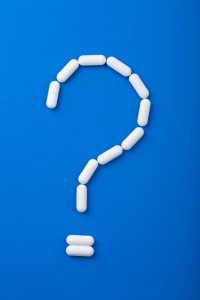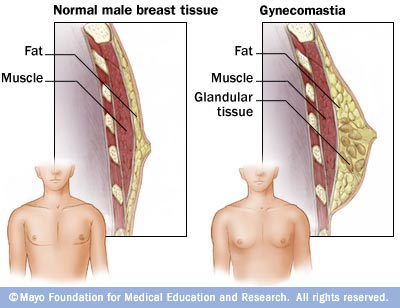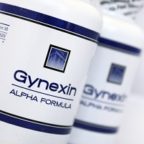 Man breasts are typically a point of embarrassment for men who have it, and while generally harmless, it can be a cause for concern. In certain cases, male gynecomastia, which is characterized by the apparent enlargement of breast tissues, becomes a condition that necessitates medical attention.
Man breasts are typically a point of embarrassment for men who have it, and while generally harmless, it can be a cause for concern. In certain cases, male gynecomastia, which is characterized by the apparent enlargement of breast tissues, becomes a condition that necessitates medical attention.
Since men are often not too keen on discussing man breasts (even with their physician), it would be good to have access to reliable information as to what gynaecomastia is all about and how best to approach this condition.
Gynecomastia may be present in newly-born male infants as a result of acquiring estrogen from their mothers via the placenta during gestation. There are also boys who have some kind of breast development during puberty because of hormonal changes in their bodies.
While doing my own research I found out that in adolescent males, the 75% rate of pubertal gynecomastia cases, often of a psychological distress source, are resolved without treatment within 24 months of its onset. In older males, decreased production of testosterone and increased estrogen production due to acquired body fat can lead to excessive growth of breast tissue.
Check the Q&A section at the end where the most common questions are answered.
What are the Common Causes of Gynecomastia?
Although there are numerous theories on the causes of gynecomastia, my doctor said the actual reasons for it are unknown in at least 25% of its reported cases. Well, maybe I’m in that magic circle of 25%?
Some think that gynecomastia is caused by decreased estrogen production, an alteration of the estrogen to androgen ratio, a reduction in androgen production or combinations of these elements.
Even without pinpointing the exact cause for my gynecomastia, however, like I mentioned earlier, I knew how important it was to obtain gynecomastia treatment for those afflicted with it, including me, of course.
1. Natural Hormonal Changes
If you thought estrogen is an exclusive female hormone then you’re going to have to change that opinion because men are also capable of producing it, albeit in smaller quantities, just as testosterone is also produced by women, but in smaller quantities as well.
Men produce more testosterone which controls masculine traits like body and facial hair and muscle mass while women produce more estrogen that control feminine traits like breast growth. More estrogen than testosterone production causes gynecomastia.
2. Medications

This is where it got interesting. According to my doctor, between 10% and 25% of known cases of gynecomastia are attributed to the use of medications, resulting in gynecomastia which is non-physiologic. Don’t be intimidated by the names, you can always look up the names online to see if you’re on one or two of these:
- human growth hormone
- 5-Alphe-reductase inhibitors like dutasteride and finasteride
- known antiandrogens like flutamide, spironolactone, and biculatamide
- cimetidine
- hormone analigues which are gonadotropin-releasing
- ketoconazole
- human chorionic gonadotropin
If you have an existing heart condition, taking calcium channel blocker medications like nifedipine, verapamil, and amlodipine, anabolic steroids, risperidone, opiods, alkylating agents, omeprazole, and efavirenz may also be triggers for gynecomastia.
If you’re vain and you use shampoos, soaps, shower gels, and lotions which have ingredients like lavender, tea tree, and other plant oils, and herbs….well, you might have to switch to something more simple than those because these plants have been linked to gynecomastia. Ditto for supplements such as Tribulus terrestris and Dong Quai.
Use of anabolic steroids – regular and/or prolonged use of steroids, whether for the purpose of body building or otherwise, inhibits the production of testosterone, which leads to the increase in breast tissue size.
3. Alcohol and Other Substances
Alcohol is also a trigger, along with methadone, amphetamines, heroin, and marijuana.
4. Chronic Diseases
Male individuals who have chronic diseases are also at risk for development of gynecomastia. Kidney failure as a result of malnourishment in a male patient causes hormonal imbalances, my doctor said, because there is considerable damage in the testicles and suppressed testosterone production due to high urea levels, known as hypogonadism associated with uremia.
Hypogonadism causes significant diminished functionality of the gonads (testes in the case of males), which in turn interferes with the production of testosterone. Pituitary insufficiency has been tightly connected with breast enlargement in men, as well as retardation of secondary sexual characteristics. Among the most apparent symptoms of hypogonadism is small testicles.
Also, males who are afflicted with cirrhosis or liver failure are also susceptible to develop gynecomastic. If the liver is unable to metabolize estrogen, it is impaired. Additionally, males who are alcoholics and already have liver disease are at high risk to acquire gynecomastia because the ethanol is liable to disrupt testosterone synthesis. The phytoestrogens present in alcohol are also contributory to increasing the estrogen level higher than that of the testosterone.
5. Tumors
The presence of tumors – like Sertoli cell tumors or Leydig cell tumors — in the testicles could result in developing gynecomastia. Other tumors which could alter the balance of the estrogen-testosterone ratio to cause or trigger male gynecomastia include pituitary gland tumors like prolactinoma, bronchogenic carcinoma, and adrenocortical tumors.
Male patients with prostate cancer condition may experience an onset of gynecomastia if treated with therapy using androgen deprivation.
6. Ageing
Age can be a factor and overweight males are at a higher risk to develop gynecomastia. Because of advancing age, there is a decline in testosterone production which can increase the accumulation of subcutaneous fatty tissue. This is a normal part of the ageing process and is called senile gynecomastia.
Developing man breasts is typical among males above fifty years of age, especially those who are genetically predisposed to retaining fats in certain areas of the body such as buttocks, stomach, and chest.
7. Hyperthyroidism
Gynecomastia may develop if there is excessive production of thyroxine by the thyroid gland.
 8. Obesity
8. Obesity
Men who are overweight are more likely to develop enlarged breasts due to significant fat build-up in the chest as well as stomach area.
9. Hormone Infused Poultry
Many poultry products such as eggs and chickens these days are loaded with hormones, which can cause breast enlargement in men as well as women. These growth hormones inadvertently facilitate cell division, which can cause not only enlargement but the development of cancer as well.
Risk Factors to be Aware Of
My doctor gave me a recap on the risky factors in acquiring gynecomastia so you can be prepared for it if it decides to visit you:
- Adolescence.
- Older age.
- Previous usage of performance-enhancing drugs such as androgens or anabolic steroids.
- Underlying medical conditions such as Klinefelter syndrome, liver, thyroid, and kidney diseases, and tumors which are hormonally active.
- Not using the Post Cycle Therapy or PCT, if you’re a bodybuilder.
Gynecomastia Symptoms and Cardinal Features

Visible Enlargement of Breasts
The most obvious sign of male gynecomastia is the enlargement of a male’s breast, with firm subcutaneous tissue in the chest which extends outward from the nipple’s areola. Such enlargement typically occurs either only on one or both sides; this condition may be cause for anxiety, stress or panic in the affected individual who may assume that the condition is breast cancer.
Enlarged breast tissue may be painful or tender. Asymmetry of the chest tissue as well as an increase in the areola’s diameter could also be obvious symptoms of gynecomastia; swelling of the breast, which may or may not be accompanied by pain, and discharge from a nipple in one breast or from nipples of both breasts are also symptoms of gynecomastia.
Male breasts are typically flat (especially the nipples) and devoid of flesh. In the case of male gynecomastia, the breasts become soft, supple, and full. They are quite apparent even when wearing clothes, which is what makes the condition rather embarrassing.
Distended Nipples and Puffy Areola
Normal male breasts are made of flat nipples and areolas. Gynecomastia causes the nipples to become raised and distended while the areolas tend to become larger and puffier (there is some discoloration as well). In short, they start to resemble female (functional) breasts.
Symptoms that are cause for concern include the following:
- Breast tenderness and/or unusual sensitivity/pain
- Leakage (any type of fluid or secretion)
- Uneven/asymmetrical breasts (one smaller and the other one larger)
- Lump/mass
- Confirmed calcium deposit or calcified milk
- Significant reduction if not total absence of libido
If/when you experience one or more of the symptoms listed above, be sure to submit for a comprehensive check-up. Most physicians would recommend tests to ascertain the nature of the condition and the initial prognosis.
Physical and Psychological Effects of Male Gynecomastia
Limited Physical Activities
Men are generally used to carrying significant load in their chests, so having enlarged breasts would certainly hamper movements to a certain degree. Certain types of exercises will become difficult, if not impossible, to perform such as running/jogging, curl-ups, jumping jacks, and pretty much everything else that requires running and/or jumping up and down.
Depression, Anxiety, and Overall Emotional Distress
While enlarged male breasts are not necessarily life threatening, it can be quite disconcerting especially since large breasts are a predominantly female attribute. Men who suffer from this condition often feel emasculated and extremely conscious of their appearance. In severe cases, affected males start covering up their chest area by wearing thick layers of clothing (regardless of the prevailing weather) in order to steer people’s attention away from their breasts.
The embarrassment over their physical appearance may also extend to their overall social behavior, which usually starts with avoiding people, especially the opposite sex. Since having enlarged breasts is attributed to feeling less of a man, it can cause one’s self esteem and confidence to plummet. Dating, or even being around women in general, becomes more of a chore for men with this condition, which can have long term implications.
How to Cope with Gynecomastia
 I kid you not, having enlarged breasts can be extremely stressful as well as embarrassing at the same time, mainly because gynecomastia is difficult to hide.
I kid you not, having enlarged breasts can be extremely stressful as well as embarrassing at the same time, mainly because gynecomastia is difficult to hide.
For adolescent boys, it could mean getting bullied or publicly humiliated, making ordinary activities such as showering after P.E. or swimming in the school pool a traumatic experience each time.
I didn’t have gynecomastia when I was a teenager, thank my lucky stars. But I do have it now, as well as feelings of helplessness, shame, confusion, anxiety, and fear. While my doctor said these are normal, I need to cope with them if I want to have a normal and healthy life physically, socially, emotionally, and mentally.
Here are some of the ways which have helped me cope with my condition:
Counseling: depression and anxiety caused by a gynecomastic condition can be alleviated with the so-called “talk therapy” and it doesn’t necessarily have to be with a psychiatrist. You can talk with your partner/spouse/significant other, family members or close friends to let them know and understand what you’re undergoing.
Psychiatric therapy: if you’re apprehensive or embarrassed about having to let other people know of your condition, seek professional help with psychiatric therapy. This can reduce your stress considerably because you can “let out steam,” so to speak, when you can discuss what you’re undergoing with an individual who has had experience in dealing with it vicariously; in this case, your doctor. He or she could also recommend other forms of physiological treatments for your condition such as taking male breast reduction pills.
Support group: connecting with other individuals who are undergoing gynecomastia or have gone through it is another excellent way of coping with your own personal condition. Some websites for instance, have a forum that might prove helpful to you as a resource for networking with others who have the same condition as you do. I join in the forum discussions once in a while, which is therapeutic for me.
When Should You Seek Medical Attention
Apart from the above-mentioned physical symptoms, severe emotional stress is a cause for concern, which justifies a trip to the doctor. The psychological effects of male gynecomastia can be far more damaging than the physical ones, and they should be addressed properly. Once it has been determined that the enlargement is not of any significant threat to your health, it is time to explore a number of options on how to treat the condition.
Treatment Options for Gynecomastia
Surgery
Those who do not mind going under the knife can consider surgery as a quick and long term solution for enlarged breasts. The procedure itself is quite simple, as the surgeon simply removes the excess flesh and fat (Mammoplasty). However, since this option is costly and not without risks, it is often the last resort for most men.
Topical Solutions
There are creams sold online as well as some pharmacies that are formulated to target and remove excess fat on the breasts. These solutions are quite affordable but are often unreliable so you cannot always count on excellent results.
Natural Supplements/Pills
Since hormonal imbalance is the usual proximal cause of Gynecomastia, there are a number of natural supplements that are specifically formulated to correct it. There are certain natural pills sold online that offer effective breast reduction for men sans any serious side effects.
When choosing a treatment options for gynecomastia, it is first necessary to understand the pros and cons of each one. In most cases, natural treatments are most ideal since they do not have any serious drawbacks that can affect one’s health.
Q&A Section (popular reader’s quesions answered):
What does gynecomastia mean?
The term gynecomastia can be a little confusing when you go online, because not everyone uses it the same way. For the longest time, doctors tended to use the term “gynecomastia” for enlarged male breasts due to a hormonal imbalance, so that there’s excessive growth of breast tissue. If the enlargement of the breasts in men is caused by fat deposits, then these doctors call this condition “pseudogynecomastia”.
Most of the time nowadays, however, most people use the term “gynecomastia” for the enlargement of the male breasts regardless of what caused it. The term is somehow better than just calling it “man boobs”.
Is gynecomastia a genetic disorder?
Not really. Enlarged male breasts can result from many possible causes. These possible causes include puberty, the abuse of steroids or alcohol, prescription drugs, aging which causes hormonal imbalances due to low testosterone, obesity, and cancer.
But it is possible that a genetic disorder may cause breast enlargement in men. One example is Klinefelter’s Syndrome, which isn’t really rare since it happens in 1 out of 500 to 1,000 males. That means it may affect as many as 544,000 men in the US alone. It’s just that this condition is rarely diagnosed.
With this syndrome, men who usually have just an X and a Y chromosome have an extra X chromosome. Many men who have this condition don’t show any obvious symptoms. But some may have large breasts as a result.
Which doctors diagnose gynecomastia?
The diagnosis of gynecomastia can be done by your family physician. But you may want to go to a doctor that specializes in this condition. Usually this doctor is a plastic surgeon who specializes in gynecomastia surgery. This specialist can confirm the diagnosis, and then provide a proper treatment for the condition.
What are gynecomastia symptoms?
Usually, the condition presents itself as having one or two breasts larger than usual. However, it may also come with some other symptoms that necessitate a visit to your doctor. These symptoms include pain, tenderness, or swelling in your breasts, or if there’s some nipple discharge from one or both breasts.
Check the best alternative gyno treatments compared










{ 2 comments… read them below or add one }
I am Male 28
Right Breast slight bigger then left
lump is soft not hard and no discharge nipple become hard on touch..
is it breast cancer
Hi. I don’t think it is a breast cancer. However, if you have any doubts go to check it with a doctor to be sure.